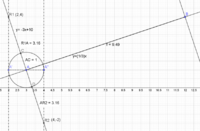Hi,
I'm new in this forum and consider a non-mathematical person.
I have a problem with missing coordinate problem as shown in here

Let A(3,1) and B(12,4) is a segment with dist(A,B) = 9.49
CAB and DAB are right-angled triangles. dist(A,C) = dist (A,D) = 1, and dist(B,C) and dist(B,D) = 9.54
I need to solve the mystery of finding the coordinates for C and D
Most of the resources I got to solve this problem have C, A and D on X-axis. Due to my lack of luck, I couldn't find the solution to my problem.
The location of C and D can be easily got using Geogebra, but honestly, I don't know how they do the magic.?
To obtain the points in Geogebra, here is what I do:
1. Create a perpendicular line L from segment AB at point A
2. Create a circle C with r=1 at A
3. Obtain intersection L with C
Are there any other methods using the value from triangles only?
I really appreciate your help
Cheers
I'm new in this forum and consider a non-mathematical person.
I have a problem with missing coordinate problem as shown in here

Let A(3,1) and B(12,4) is a segment with dist(A,B) = 9.49
CAB and DAB are right-angled triangles. dist(A,C) = dist (A,D) = 1, and dist(B,C) and dist(B,D) = 9.54
I need to solve the mystery of finding the coordinates for C and D
Most of the resources I got to solve this problem have C, A and D on X-axis. Due to my lack of luck, I couldn't find the solution to my problem.
The location of C and D can be easily got using Geogebra, but honestly, I don't know how they do the magic.?
To obtain the points in Geogebra, here is what I do:
1. Create a perpendicular line L from segment AB at point A
2. Create a circle C with r=1 at A
3. Obtain intersection L with C
Are there any other methods using the value from triangles only?
I really appreciate your help
Cheers
Last edited:

